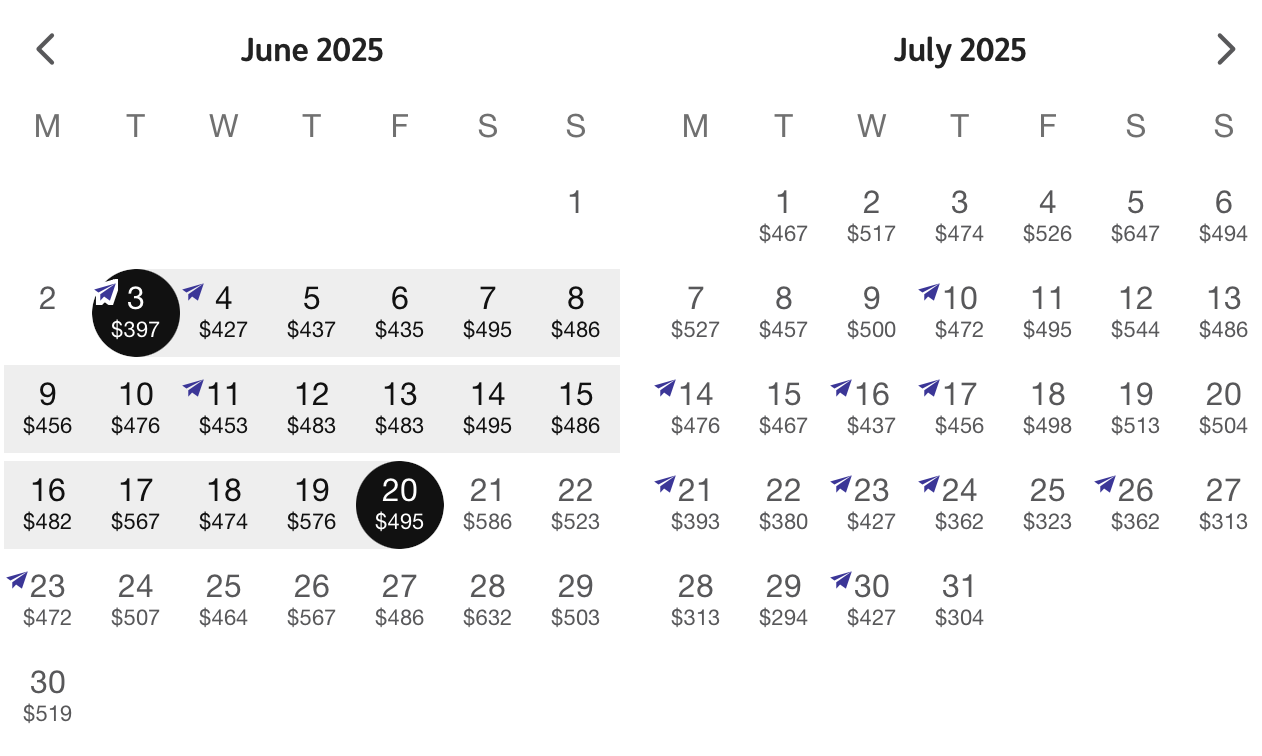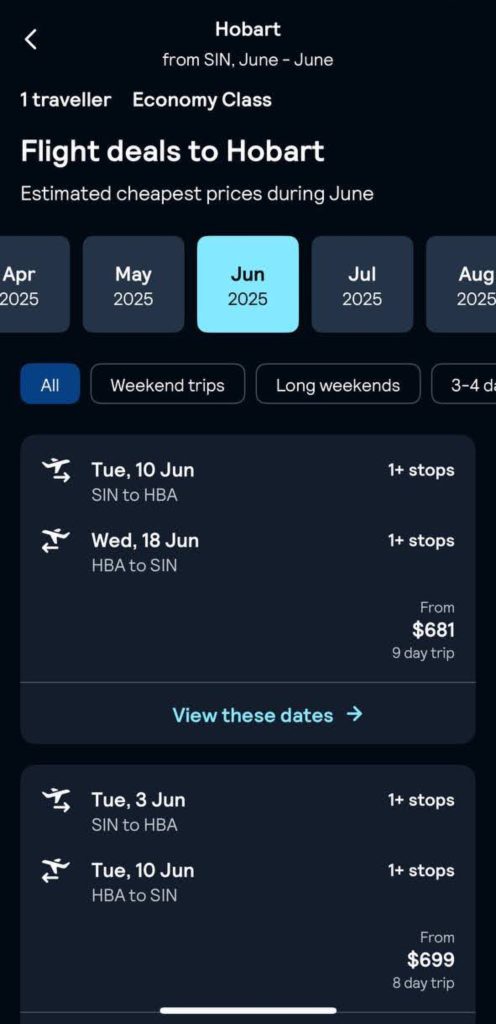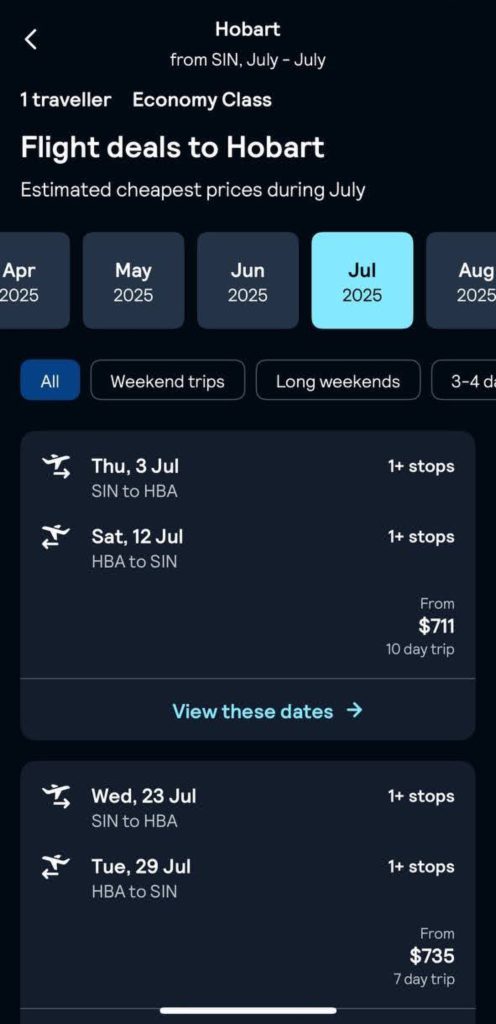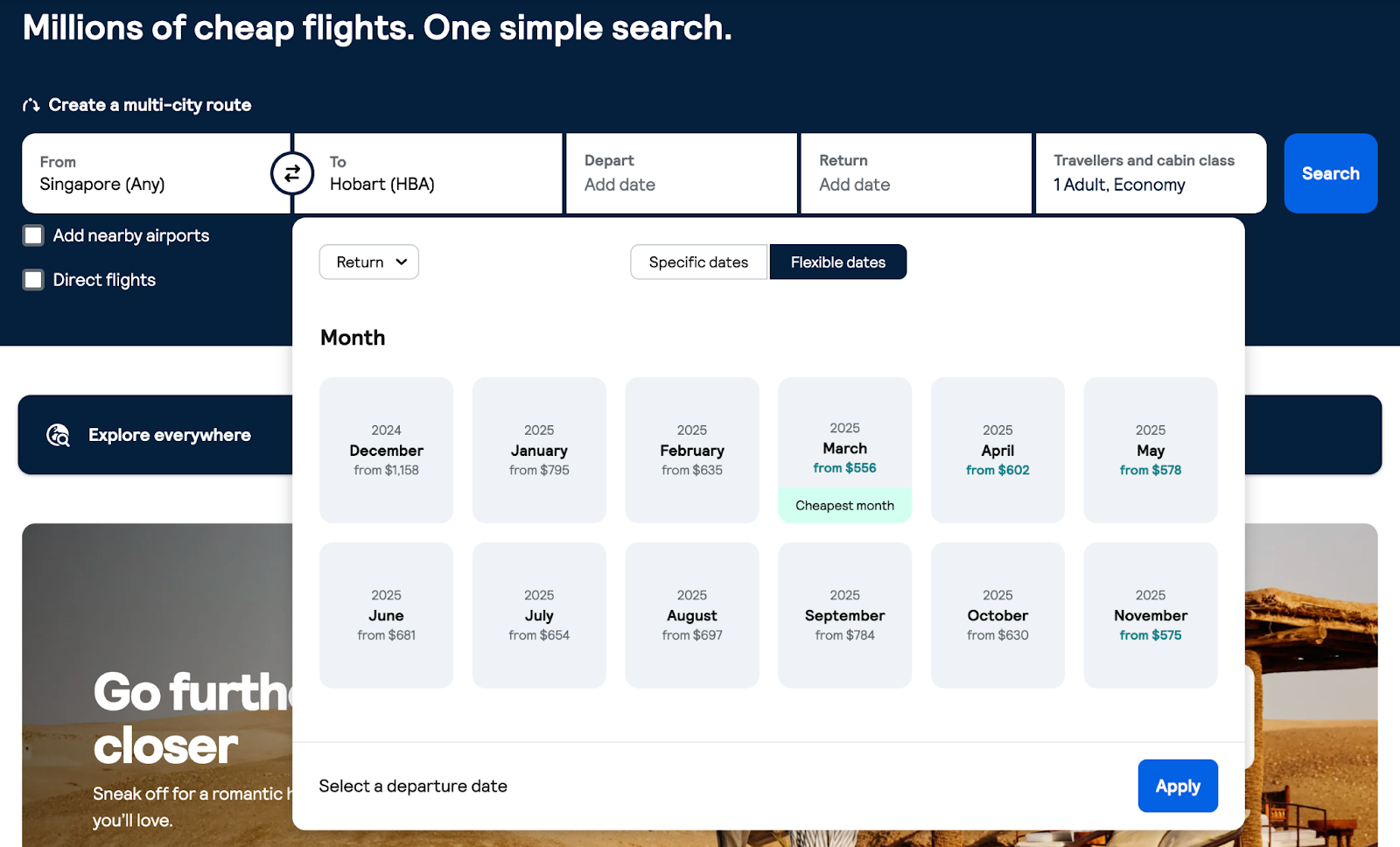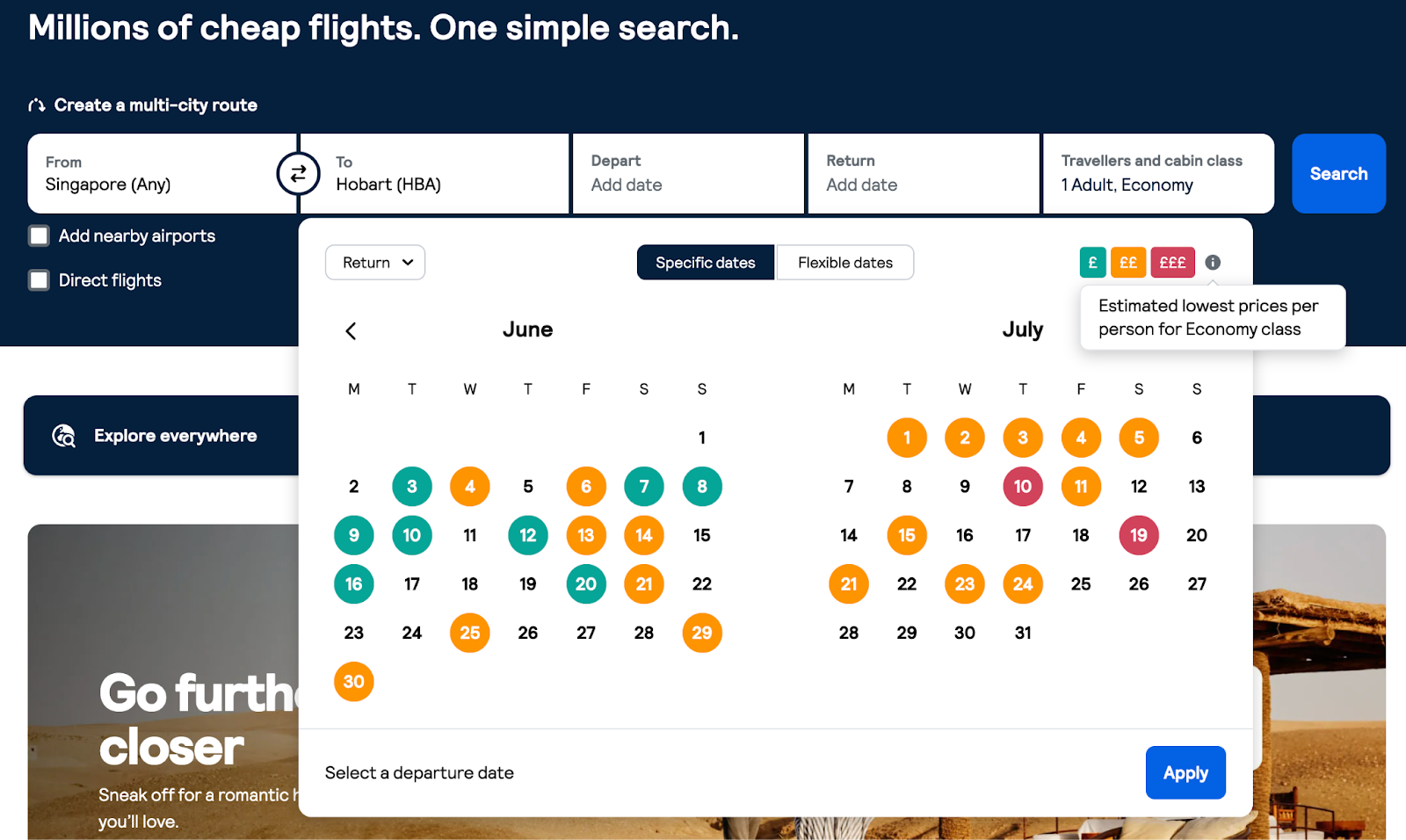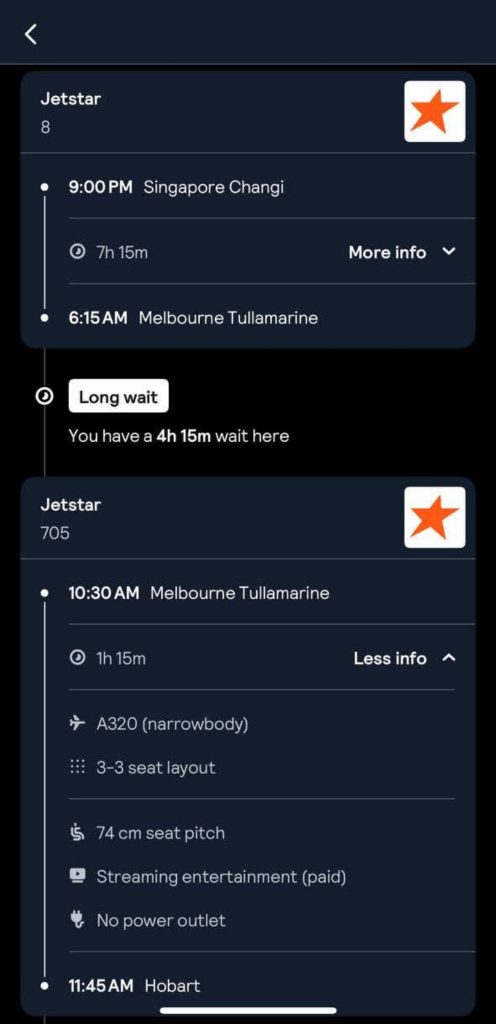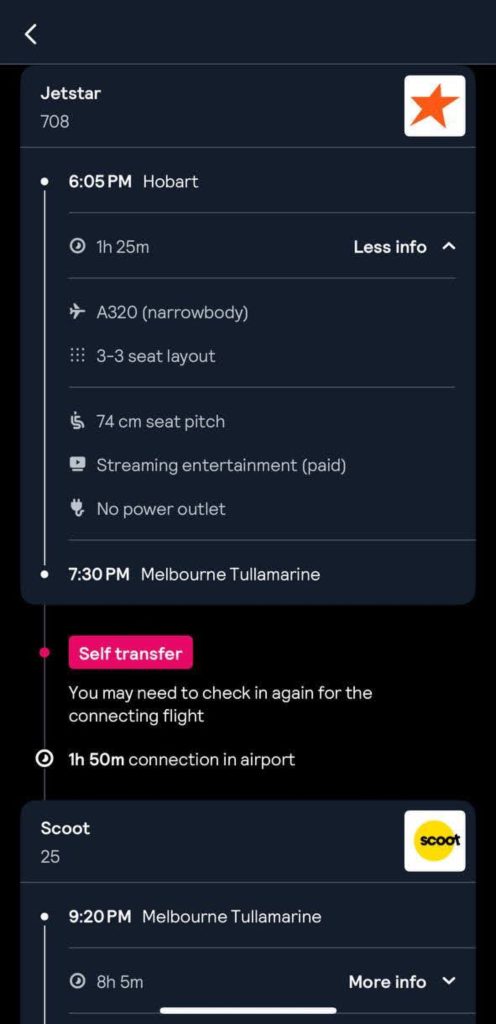I tried booking flights directly from airlines, but here’s why Skyscanner won me over
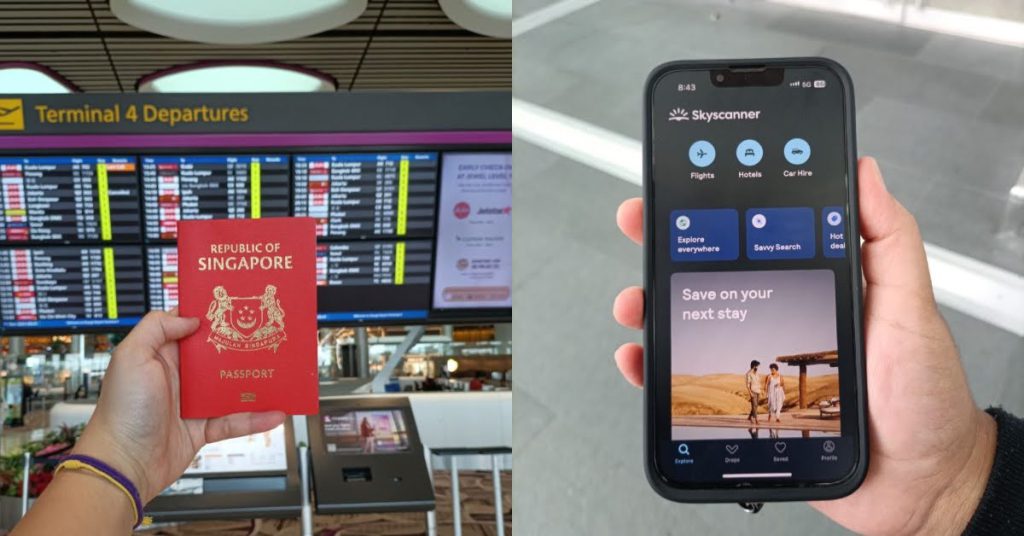
[This is a sponsored article with Skyscanner.]
I recently came across a Skyscanner survey on the top travel trends for 2025, and suddenly, it hit me—I hadn’t made any travel plans for the year yet.
The survey contained a list of best-value destinations for 2025, and one particular location immediately stood out to me: Hobart, Tasmania.
I’ve always dreamt of visiting Tasmania and seeing the Southern Lights, which has been high on my bucket list.
They’re expected to peak in July 2025, and with flight prices down 14% compared to last year according to the survey, it felt like the perfect opportunity, so why not go for it?
Travel planning can be a test of patience
Like any budget-conscious traveller, I wanted to compare the best prices for visiting Tasmania.
The prime months to witness the Southern Lights are during winter, between May and September. However, since the aurora is expected to peak in July, I decided to narrow my search down to the months of June and July.
At first, I tried booking my flight directly through airline websites, but I encountered challenges particularly when trying to identify the best prices and flight options.
More often than not, I had to manually select dates on the websites and compare prices across them, which was painfully tedious.
Even when airlines did offer price comparisons, they just weren’t comprehensive enough to be truly helpful.
Navigating these platforms was far from smooth, and their clunky interfaces made the whole process feel like a hassle.
A seamless experience from search to purchase
That’s when I checked out the Skyscanner mobile app.
Skyscanner compares flight deals and offers from more than 1,200 airlines and travel providers. Since I wasn’t sure when to depart and wanted to select the most affordable dates, I simply filled in my departure city and destination.
The platform then generated a list of flights for each month, conveniently sorted from the most affordable to the priciest options.
The search results showed that traveling from June 10 to June 18 was the most affordable option, so I decided to secure my booking right away. If you’re looking to make the most of your leave days, the app also lets you filter flights for long weekends or weekend getaways.
On desktop, the Skyscanner platform has a “Cheapest Month” tool that displays the starting prices for flights each month, allowing you to easily identify the most budget friendly times to travel to your destination.
Once you’ve chosen your preferred month, the platform can also generate a handy colour-coded calendar, making it easy to spot the best travel dates at a glance. Green dots indicate the most affordable dates, followed by yellow for moderately priced ones. Red dots mark the priciest options.
Another convenient feature I noticed on the Skyscanner app is that it provides additional information about flight options, including layover durations for connecting flights. Some of the airline websites I visited didn’t offer this information, so I had to manually calculate the waiting times myself, which added to the hassle.
The Skyscanner app even covers the finer details, like the layout of the plane, availability of power outlets, and in-flight entertainment.
Overall, using the Skyscanner app was seamless from search to purchase. After finding the best flight option, the app redirected me to the relevant partner websites—in this case, Scoot and Jetstar—to finalise my booking.
It made trip planning more transparent, quicker, and hassle-free, without needing to check multiple flight providers.
More useful tools to simplify vacation preparations
Beyond the easy search process that helped me secure the best deal for my trip, the platform also offers a range of other tools which can be useful in simplifying vacation preparations.
For instance, the Skyscanner app lets you create a Saved list to track the destinations you’re interested in and automatically receive price alerts whenever the airfare changes, so you are always updated on any price drops.
Simply log in to your Skyscanner account and tap the heart icon next to the flight you’re eyeing to set up the alerts. You can even create separate Saved lists for all the different trips you’re planning.
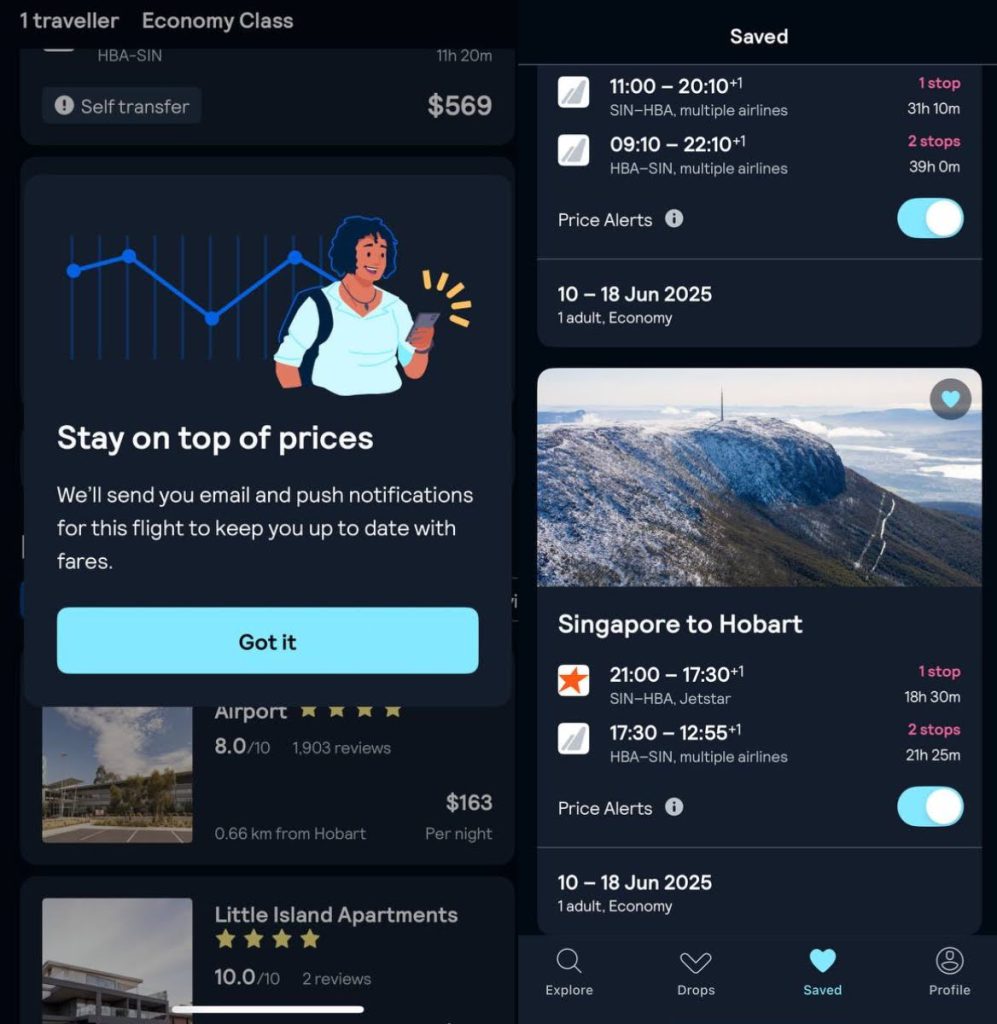
Not sure where to travel? Just use the Everywhere Search tool and you’ll be shown the most affordable destinations for your preferred travel period or for all time.
Plus, if you need additional inspiration, the platform has recently launched an AI search feature on its app. You can ask the Savvy Search function for inspiration, and it’ll provide you with a curated list of travel recommendations and flight prices.
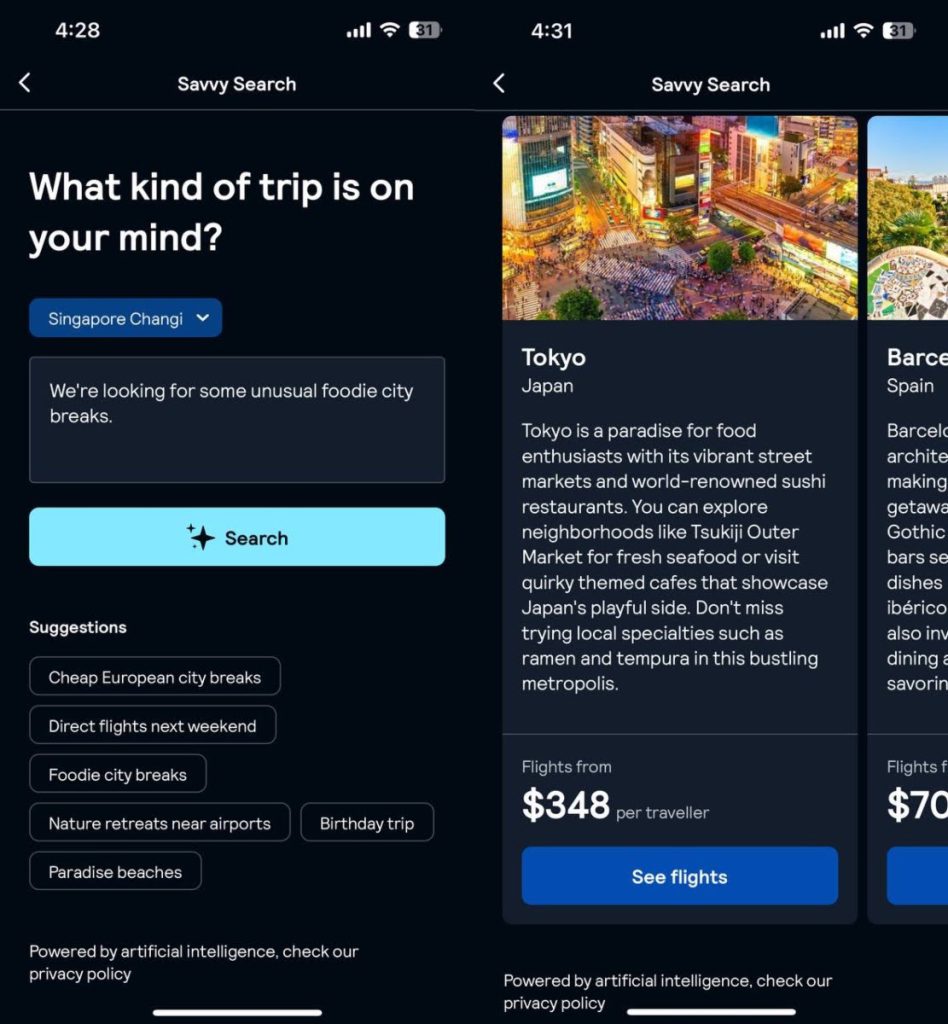
In addition to flights, Skyscanner lets you book accommodation based on your preferences, with filters for hotel stars, ratings, or prices. You can also compare car rental prices from thousands of providers to find the best deals for your next trip.
Maximise your travel budget with Skyscanner
If you’re looking to book your vacation for 2025, make sure to check out Skyscanner’s 2025 Travel Trends survey too.
In addition to Hobart, Tasmania, the survey revealed the best value destinations for 2025, with other locations that have seen price drops of as much as 41% as compared to last year.
The survey also unpacks other travel trends, including the top trending destinations for Singaporeans next year.
You can explore these insights and start planning your next trip by checking out the Skyscanner website here or by downloading the app here for Android, and here for iOS.
- Read other articles we’ve written about Singaporean startups here.
Also Read: YouTrip was my travel companion for my Vietnam trip – does it still offer best rates in 2023?
Featured Image Credit: Vulcan Post
“Don’t build to exit”: Reformer Pilates pioneer The Flow Studio on scaling & bagging funds
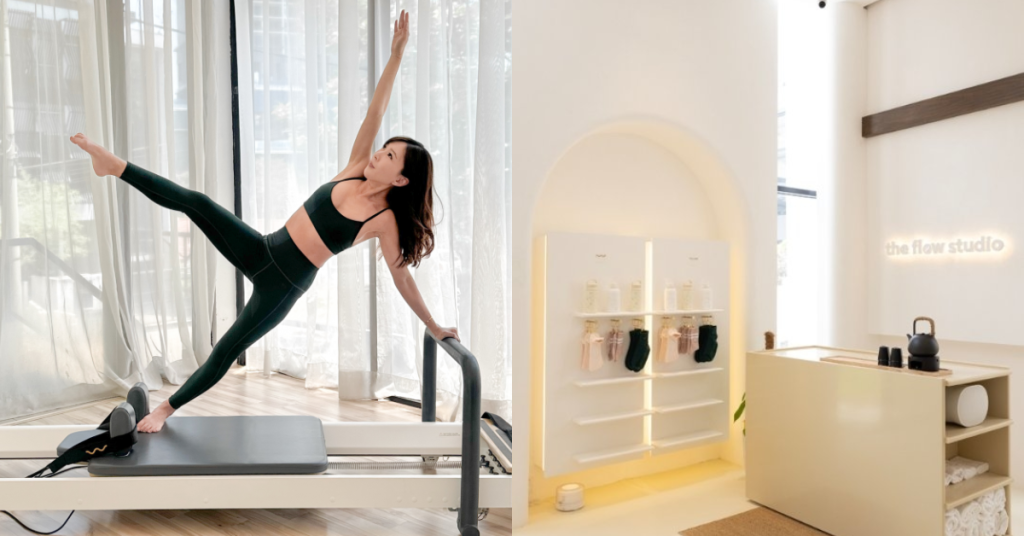
It’s not every day a non-tech business closes institutional funding, much less a yoga studio.
Yet, that’s something homegrown yoga and Pilates brand The Flow Studio has done, having raised an undisclosed amount of funding from Bintang Capital Partners just recently.
And there’s a compelling reason why.
Behind the flow
The woman who started The Flow Studio is Tiffany Yow.
Hailing from Malaysia, Tiffany was stationed in Melbourne for some years. In her past life, she was an investment banker, a field which had been populated with… well, people who weren’t like her.
“It was quite a stressful environment. At the time, I was probably the only female in my team. I was also probably the only Asian in my team,” she told Vulcan Post.
To unwind, she attempted going for various workout classes, but none of them stuck. In fact, she even dreaded going to them.
It was finally in Reformer Pilates that she found resonance.
“Don’t get me wrong, I’ve always been an active person,” Tiffany prefaced. “All throughout school, I was in gymnastics. I was in cheerleading, I was in ice skating, I was in running. So, I sat down and I thought about it, and I realised it was actually the environment.”
In hindsight, she realised she disliked commercial gyms. They were oftentimes crowded and unpleasant with no personal touch or inviting ambience.
But beyond the environment, it was also about the workout itself. After a high-stress job, Tiffany just didn’t have it in her to go for another high-intensity and high-energy workout.
“With Reformer Pilates, it’s low impact, it’s safe on your joints, but at the same time, after a month or two of going consistently, I was seeing results in my body,” she pointed out.
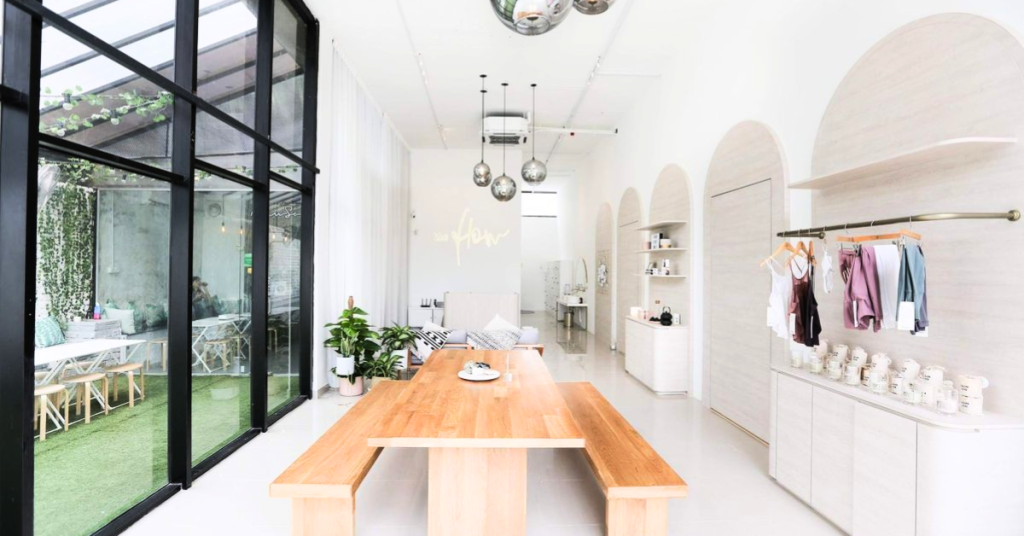
When visiting family in KL, though, Tiffany realised that good classes were not readily available in Malaysia. No one really knew about the Reformer equipment, and those who offered it were doing it at an exorbitant price. The timing, too, was more catered towards those with more flexible schedules, such as retirees or stay-at-home parents.
There was also a stigma that it was meant for those recovering from injury or have mobility issues.
“A majority of our population are healthy, so why aren’t we programming the sessions to healthy bodies?” she wondered.
Young and fit individuals opted for spin or HIIT classes because they could actually feel something.
But Reformer Pilates could also offer that, with the right programming. This ambition was what led to the “Sweat, Burn, Shake” core principle at The Flow Studio.
“Long story short, I noticed this gap in the market in KL of making Pilates fun, enjoyable, and accessible to everyone,” Tiffany concluded. “I wanted people our age to be doing this exercise. It’s not rehab, it’s prehab.”
Believing in this mission, Tiffany quit her Melbourne job, built her signature method of programming classes, signed a lease in Bangsar, and opened The Flow Studio in August 2018.
Educating clients and instructors
But what really sets the brand apart from the countless other studios around town?
To Tiffany, it all boils down to education.
All of The Flow Studio’s instructors are internationally certified. But more than that, they also undergo a rigorous internal training programme—even if they have been teaching elsewhere for decades.
This course involves in-person lectures, class attendance, class observation, assessments, and ongoing mentoring. They’re also equipped to handle classes with students that have injuries or pregnancies.
“As soon as your name is on our schedule, our students know that they’ll get a good quality class no matter whose class they attend,” Tiffany said.
The studio has started offering their own Reformer Pilates Teacher Training Programme.
“We were seeing a lot of instructors who had certifications, but when they came in to do the interview, we realised a lot of them are actually not ready to teach,” Tiffany said.
Essentially, these instructors could memorise the text and repertoire memorisation, but that doesn’t actually translate into a good class.
Leveraging their years of expertise, the team has combined the best bits of different training ideologies to create their own comprehensive programme.
Tiffany pointed out that it’s started to get competitive in the Pilates training space too. There are people offering one-week or two-week training comprising all Pilates apparatus.
Meanwhile, The Flow Studio offers a two-week full-time programme on just the Reformer apparatus. From foundations of anatomy to learning about posture, The Flow Studio’s programme seeks to delve beneath the surface.
Plus, it’s more affordable compared to all the licensed US-based training offered by other schools, since theirs is locally created.
At the same time, there’s also education on the client front, explaining why quality classes are important, rather than just going for the most affordable classes at studios where instructors might not have the proper qualifications.
Funding is easy, other values are hard
Starting out, Tiffany never thought about growing too big.
Yet, even through the pandemic, the business was able to keep themselves in the green by renting out Reformers to people’s houses and doing online classes.
With a solid business model, it made sense why investors and interested business partners were lining up to inquire about the business.
But Tiffany knew she didn’t want to just partner up with anyone.
“To me, money or capital is the cheapest thing,” she said. “It’s not very difficult to raise capital or get someone to invest in your business if your business is profitable, and it has a decent, good track record. What is difficult to find are partners that are also able to contribute, not just monetarily,” she said.
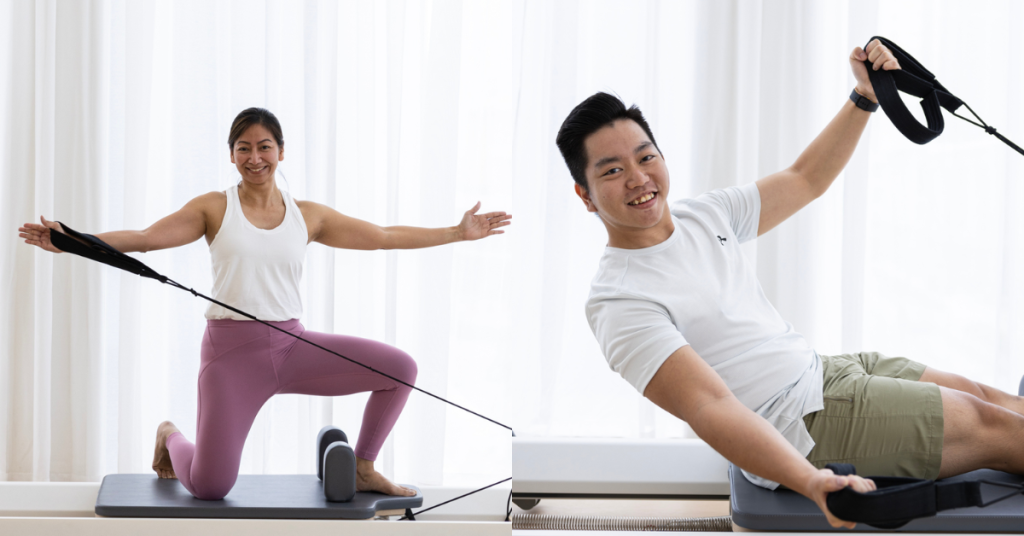
It was through a friend that really believed in the business that she became connected with Bintang Capital Partners’ Johan Rozali-Wathooth.
Through an informal conversation between the two, it became clear that The Flow Studio was a business worth investing in, especially from an impact standpoint.
“Compared to a lot of businesses, we are female-led, and we also provide a lot of employment opportunities for women after having children. We employ single mothers and sponsor certifications,” she said.
And on an environmental perspective, they have a low carbon footprint as Reformer equipment doesn’t require electricity. They’re also making a social impact as they are promoting mental health and physical wellbeing.
Moreover, there was alignment. Instead of pushing them to scale rapidly, Bintang understood the sustainable approach that The Flow Studio wanted to take.
Bringing this impact abroad
With this support from Bintang, The Flow Studio is readier than ever to bring their impact abroad.
The Flow Studio is actually already in Singapore. In fact, they have three outlets —a great feat, considering that the fitness and Pilates market in the island is more mature and thus competitive compared to Malaysia.

While that has presented challenges, Tiffany shared that their educational approach has remained effective in Singapore.
Leveraging this experience, Tiffany now wants to bring it to other countries where Reformer Pilates is still not as accessible yet.
On top of that, they aim to extend HRD Corp-claimable programmes to target more corporate clients.
Not building to exit
When asking the founder for business advice, there was just one thing that she shared—-don’t build to exit.
“I know that’s a bit of a controversial thing to say in today’s world,” she said.
Instead of building to get high valuation, she always wanted to create something sustainable to serve the community for years to come.
“You have to be acutely aware that growing a business and running a business takes everything. You think that doing your passion, everything is very fun, it’s glamorous, and you’ll be doing something you love every day of your life. But it’s a lot tougher than working a full-time job,” she shared.
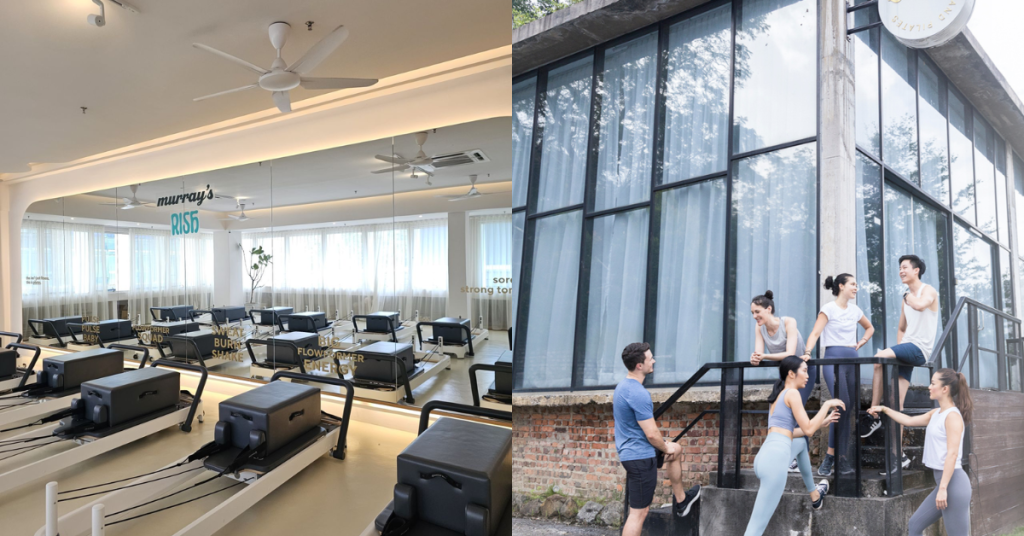
“It’s very easy to start, but where does it go from there?”
She also thinks it’s vital for entrepreneurs to really integrate themselves into the business.
From cleaning the rooms and manning the front desk to marketing and programming of classes, Tiffany has done it all. “I firmly believe that if you want to start a business, you also need to start from the bottom.”
Understanding each part of the business has allowed Tiffany to be equipped to bring her business to the next stage—not to exit, but to last.
- Learn more about The Flow Studio here.
- Read other articles we’ve written about Malaysian startups here.
Also Read: Inside the exclusive programme for startups by Grab Malaysia, GXBank leaders & Endeavor Malaysia
Featured Image Credit: The Flow Studio

